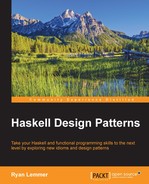Typeclasses with one type parameter are of kind (* -> *), for example:
class Show a :: * -> * class Maybe a :: * -> *
If we declare an instance of Show, then the typeclass parameters in the kind signatures need to be aligned, for example, consider:
instance (Show a) => Show (Maybe a) where ...
In order to match the kind of a :: * in Show a, we use Maybe' b instead of Maybe:
Maybe' b :: * -- instead of Maybe :: (* -> *)
The Monad type-class is of a higher-order than Show and Maybe:
class Monad m :: (* -> *) -> * -- m -> Monad m
The Show type-class is parameterized over type a :: *; whereas Monad is parameterized over the type constructor m :: * -> *. This can seem like a natural and unsurprising generalization for type-classes, but was in fact an exciting leap forward for Haskell, as described in Hudak et al's History of Haskell:
"The first major, unanticipated development in the type-class story came when Mark Jones suggested parameterizing a class over a type constructor instead of over a type...
"Jones's paper appeared in 1993, the same year that monads became popular for I/O. The fact that type classes so directly supported monads made monads far more accessible and popular; and dually, the usefulness of monadic I/O ensured the adoption of higher-kinded polymorphism."
